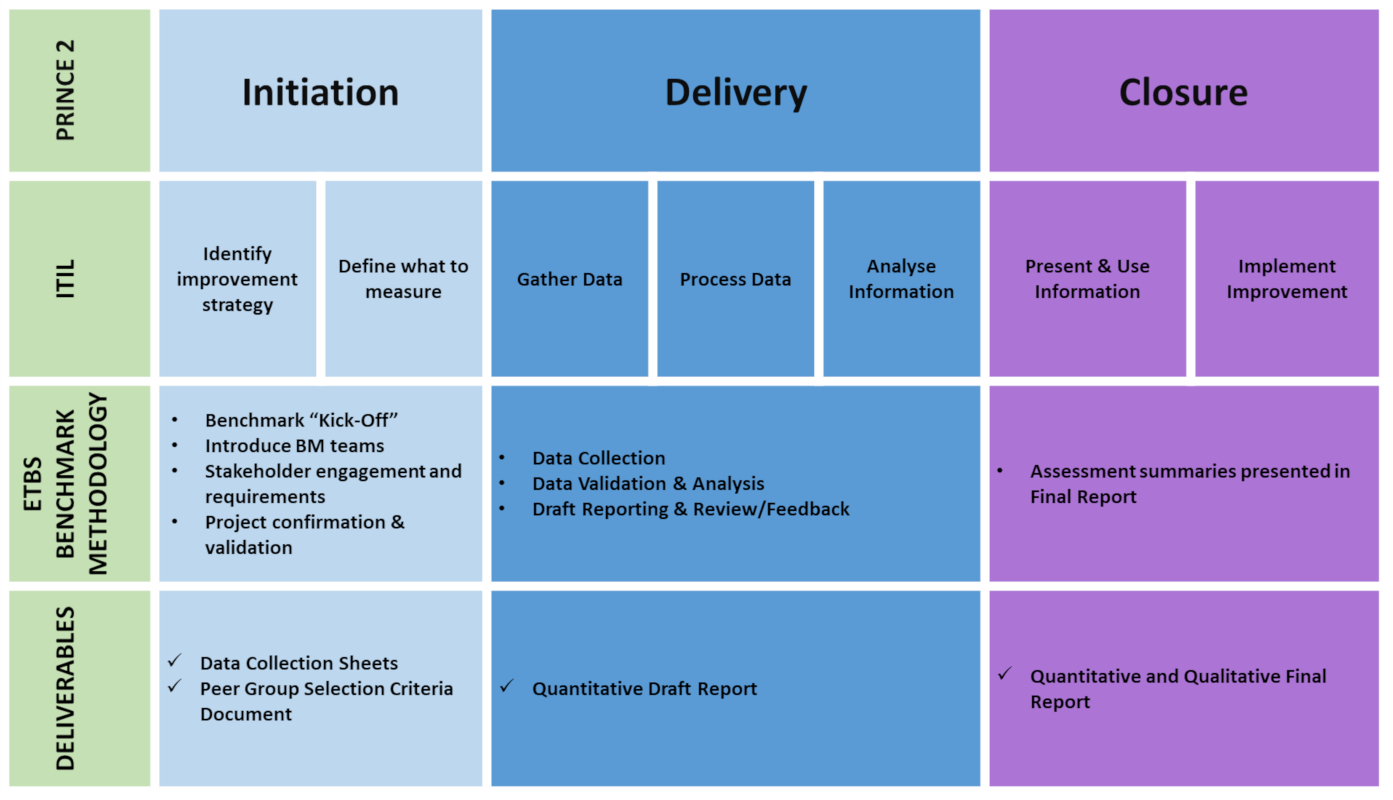Methodology
When investing in a benchmark, the objective should be strategic in nature; to measure and improve the current state of efficiency (price) and effectiveness (quality) of service.
The Benchmarking Methodology is the single most crucial component of a successful benchmarking engagement. Without robust, flexible and most importantly; agreeable processes, the entire reason to benchmark becomes questionable.
The ETBS Benchmarking Methodology core vision is to apply value-based, context-driven metrics and Resource Units (RUs), using IT Service Management (ITSM) and Project Management (PM) best practices to complement our Benchmarking processes.
ETBS is aware Benchmarking Methodologies MUST continually align to evolving ITSM & PM best practices. Therefore, at a high-level, ETBS has coupled the generic ITIL 7-Step-Improvement-Process as well as tying in aspects of the PRINCE2 Project Management methodology with that of our own Benchmarking Methodology, culminating in a holistic and repeatable cycle of Continual Service Improvement via Benchmarking.
Below is a diagrammatic representation of the ETBS’ methodology alignment:
Transparent and Demonstrable – We don’t believe in black boxes or pulling numbers from thin air.
Correct and Accepted – We avoid time wasting disputes by ensuring our methodology is agreed to by all parties.
Flexible – Every industry has its own processes and every company is unique, our experience across a wide array of clients enables us to adjust our methodology to suit each engagement.
Adaptable – Our methodology continues to evolve to meet the challenges presented by new technologies and market changes.

Below we expand on our process by outlining each step:
| Project Stage | ETBS Methodology/Approach | Key Milestones/Input-Output Activity Requirements |
| Initiation | Kick-Off Meeting |
Restating the project objectives including agreeing on and defining the services to be benchmarked Agreeing on the benchmarking methodology Reviewing the overall project timeline Introducing the project team Assigning roles and responsibilities with special focus on single points of communication contact Outline the required data and documentation relating to the environment, service levels, price/cost, volumes, contract and technology Establish the peer group selection criteria, based on the required characteristics |
| Data Collection |
Collaborative on-site data collection. This process will involve a review of handover of all material information from the Client to ETBS that may impact the benchmarking process; after reading all documentation, ETBS will (a) seek clarifications and (b) collect miscellaneous information about the Client’s challenges, and any other background information that is necessary to understand the Client’s environment. Generic information that is required includes (but is not limited): i. Contractual Information; ii. Statement of Work; iii. Service Level Agreements & Reports (measurement period is typically the most recent 12 months); iv. Volumetric data, i.e. monthly invoices etc; v. Additional documentation measuring service performance; vi. Plans, processes, policies and procedures; vii. The Client’s Satisfaction Surveys/NPS viii. Formal/Informal environmental challenges & complexities; Availability of the Client’s resources, i.e. Service Owners/Subject Matter Experts (SMEs) per Project Plan ETBS will dedicate full-time resources to this stage of the project |
|
| Peer Selection* | ETBS will develop the Peer Group Selection Criteria Document (PGSCD) with the most common characteristics organisations must have to qualify as a peer of the Client. This document will be submitted and discussed collaboratively with the Client to ensure unique business, technology, process and environmental drivers have been considered as part of the Initiation stage. | |
| Delivery | Data Validation & Analysis (Normalisation Preparation) |
During this time, ETBS will collate and validate the data handed over from the Client and identify any data gaps (if applicable) that may impact the benchmark. This rarely happens but if it does, ETBS will notify the Client the type of data missing and will work closely with the Client to address the gap. During this process, checkpoint meetings and ad-hoc calls between centralised points of contact will take place (per agreed Communication Plan). These will be to provide status updates of the progress made thus far, what is to be expected to follow and whether there are any impediments along the way. |
| Normalisation Finalisation | Once the Client’s data has been validated and analysed, ETBS will commence the normalisation process. This process makes certain that market rates represents an ‘apples-to-apples’ comparison. This process will be clearly articulated into the reporting output with commentary for the Client’s stakeholders to understand what was normalised, how much by and why. | |
| Draft Report Assembly/Submission & Review/Feedback |
Once the Client’s data has been normalised, draft report assembly is initiated. ETBS will use the project outputs and findings to date to assemble the draft report, keeping with project timescale requirements. ETBS will then complete assembly of the draft report, which will contain comparative data points for the in-scope services. The draft report contains quantitative information only, as qualitative information will be fed into the report post the Client’s review and subsequent feedback. |
|
| Closure | Final Report Submission |
Per Project Plan and ideally, ETBS will have received feedback of the draft report from the Client. i. Feedback should be formally documented (via email or letter) and/or discussed remotely via web-conferencing technology (WebEx, Teams, etc). ETBS will then modify the report to reflect the Client’s feedback (if and where applicable), thereby producing the Final Report within agreed timescales. |
| Final Presentation | ETBS will present the findings of the report to the Client’s Executive Leadership Team as appropriate and requested. |
Our methodology has been the cornerstone to our benchmarks that has allowed us to win the trust of commercial organisations and government departments in over 45 countries across the globe. Please contact us today for an obligation free first consultation to discover how ETBS can help you understand your position and improve the performance of your IT operation or managed services.
Follow Us

